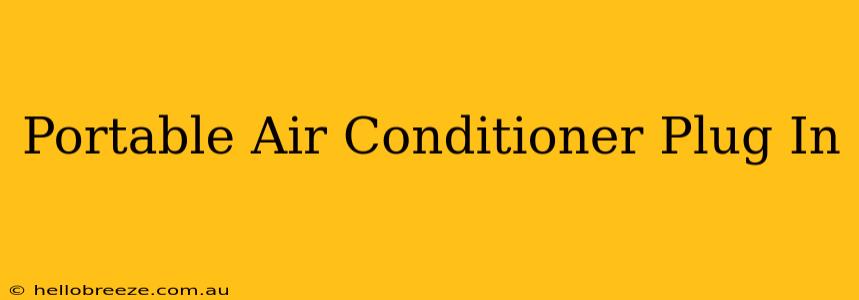Summer heat got you sweating? A portable air conditioner plug in offers a convenient and often affordable solution to beat the heat without the hassle of complicated installations. This guide explores everything you need to know about these handy units, helping you choose the perfect one for your needs.
What is a Portable Air Conditioner Plug In?
A portable air conditioner plug in is a self-contained cooling unit that doesn't require professional installation. As the name suggests, it simply plugs into a standard electrical outlet. This makes them incredibly easy to set up and move around your home, offering cooling relief wherever you need it most. Unlike window units, they don't require any permanent modifications to your home's structure.
Key Features of Portable AC Plug In Units:
- Portability: The biggest advantage! Move it from room to room as needed.
- Ease of Installation: Simply plug it in and go. No complicated installation process.
- Compact Design: Many models are designed to be space-saving, perfect for smaller apartments or rooms.
- Variety of Features: Modern models offer features like adjustable thermostats, multiple fan speeds, and even timers.
- Cooling Power: While not as powerful as central AC, they still provide significant cooling relief for smaller spaces.
Choosing the Right Portable Air Conditioner Plug In
Selecting the perfect portable air conditioner plug in depends on several factors:
1. Room Size:
This is the most critical factor. Manufacturers usually specify the square footage a unit can effectively cool. Buy a unit rated for a space slightly larger than the room you intend to cool to ensure optimal performance. Underestimating the required cooling capacity can lead to inefficient cooling and higher energy bills.
2. BTU Rating (British Thermal Units):
BTU rating indicates the cooling capacity of the unit. A higher BTU rating means more cooling power. Consider the size of the room and its insulation when choosing a BTU rating. A small room might only need a 5,000 BTU unit, while a larger room might require a 10,000 BTU or higher unit.
3. Energy Efficiency:
Look for models with a high Energy Efficiency Ratio (EER) or Energy Star rating. These ratings indicate how efficiently the unit uses energy to produce cooling. A higher EER or Energy Star rating translates to lower energy bills.
4. Features:
Consider additional features that enhance convenience and comfort:
- Remote Control: For easy operation from a distance.
- Timer: To automatically turn the unit on and off.
- Multiple Fan Speeds: For customized airflow.
- Dehumidification Function: Helpful in humid climates.
- Sleep Mode: A quieter mode for nighttime use.
Installation and Maintenance of Your Portable AC Plug In
Setting up your portable air conditioner is usually straightforward:
- Unpack and Inspect: Carefully unpack the unit and check for any damage.
- Connect the Exhaust Hose: Route the exhaust hose through a window or door to vent hot air outside. Ensure a good seal to maximize cooling efficiency.
- Plug It In: Plug the unit into a properly grounded electrical outlet.
- Fill the Water Reservoir (If Applicable): Some models use water evaporation to assist cooling. Check your model's instructions for details.
Regular maintenance prolongs the life of your portable air conditioner and ensures optimal performance:
- Clean the Filter Regularly: A dirty filter restricts airflow and reduces efficiency.
- Empty the Water Reservoir (If Applicable): Empty the water reservoir as needed.
- Clean the Condenser Coils: Periodically clean the condenser coils to improve cooling efficiency.
- Inspect the Exhaust Hose: Ensure the exhaust hose is not clogged or damaged.
Frequently Asked Questions (FAQs) about Portable AC Plug In Units
Q: Are portable air conditioners plug in units expensive to run?
A: The running cost depends on the unit's energy efficiency and the length of use. Choosing an Energy Star rated model can significantly reduce energy consumption.
Q: How much noise do portable AC plug in units make?
A: Noise levels vary between models. Some are relatively quiet, while others can be quite noisy. Check the manufacturer's specifications for decibel levels.
Q: Can I use a portable air conditioner plug in unit in any room?
A: Yes, as long as you have a suitable power outlet and a way to vent the hot air outside (window, door, etc.).
Q: Do I need to install any special venting kits?
A: Most portable AC units come with a standard venting kit. However, some may require additional accessories for specific window types or configurations.
By following this guide, you can confidently choose and use a portable air conditioner plug in to create a cool and comfortable environment in your home. Remember to consider your needs and budget when making your decision. Stay cool!

